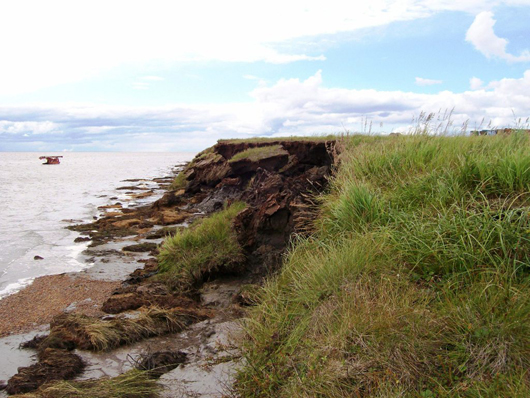How Newtok’s relocation efforts could be an example for other climate-threatened northern communities
Lessons learned in Newtok's could will prove useful to other communities facing relocation.

Time is running out for the 375 residents of Newtok, a river village soon to be washed away by the Ninglick River in Southwest Alaska.
A quarter-century campaign to move the village to a new site on higher ground — which recently received a major financial boost from Congress — may serve as a model for other villages in Alaska endangered by climate change.
Then again, the cost may be so high that it can’t be replicated at the 31 other locations in Alaska facing imminent threats from flooding and erosion.
A recent study concluded that climate change in Alaska could cause from $4 billion to $5 billion in infrastructure damage this century.
In some villages, especially those on the coast, the reduction in sea ice created by climate change leaves them open to storm damage, a more sporadic threat than that facing Newtok, which decided to try and move in 1994.
“Newtok is alone in this situation as they are facing a slow moving disaster — 70 feet of shoreline loss every year,” said Joel Neimeyer, co-chair of the federal Denali Commission.
The river will soon swallow houses, the school, village water source and the airport. A new environmental impact statement concludes that whatever is done, the “inevitable destruction of the current village site” must be acknowledged, as this is an “unstoppable catastrophe for the community of Newtok.”
So far, $47 million has been spent on the development of a new village site called Mertarvik, nine miles south on Nelson Island, but the ultimate price could be $150 million or more.
In March, Congress approved a one-time $15 million grant that will help move the work to the next stage.
“The $15 million is a game changer because it will provide housing for about half of the current community,” said Sally Cox, the relocation coordinator for the state.
A few houses have been built and others moved to the site, soon to be supplemented by surplus buildings acquired from the federal government.
Temporary power is to be provided for the first homes and there will be a home-school option for families with children.
“Currently, Newtok has no water or sewer system, and the first people who live at Mertarvik understand that complete systems won’t be developed until after some of the population is established at Mertarvik,” said Cox
“There are other ways to have running water and flush toilets outside a large piped system. The important thing is that the people of Newtok will be safe, on high ground away from the threat of erosion.”
Some of the most expensive infrastructure needed at the village — such as a functioning airport, a school and utilities — have yet to be funded.
Once a significant number of people are living at the site, the village will have an opportunity to get in line for more state and federal government grants. Those additional costs could total $80 million and may not be available for years.
The timing is uncertain, as is the future supply of state and federal funds to move villages.
The Denali Commission, a holdover from the era of Sen. Ted Stevens, has served as a conduit for federal grants to help rural Alaska. The Alaska Congressional delegation has had to fight to preserve the commission and to include money for rural Alaska.
The one thing certain for the years ahead is that the demands for help will exceed the supply of cash.
The challenge is to show real progress on the Newtok relocation effort soon, which would build confidence that such plans can be duplicated elsewhere. Failing to do so will mean that scarce federal funds will be spent in other parts of the country.
Of the Alaska villages most at risk from climate change — Newtok, Shishmaref, Kivalina, and Shaktoolik — Newtok is the closest to reaching its goal.
Of the other villages, only Shishmaref has reached consensus on a relocation site and is starting to plan. Residents of Kivalina have talked about moving for many years, but the efforts there are focused on establishing an evacuation road from the island to reach a safe site on the mainland where it hopes to build a new school.
The river erosion at Newtok is a near-term threat obvious to everyone, which has limited internal debate and created a sense of urgency.
Dermot Cole lives in Fairbanks. He can be reached at [email protected].